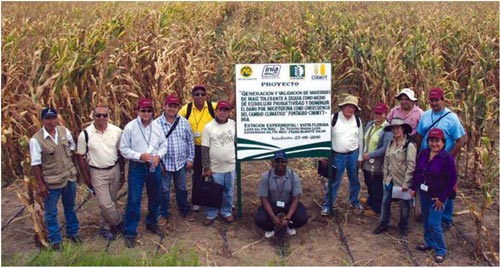 A meeting was held during 17-21 January 2011 in Chiclayo, Peru to review progress on developing maize germplasm designed to mitigate the effects of climate change and reduce contamination with mycotoxins. This work is being conducted under the FONTAGRO funded project, “Developing and validating drought tolerant maize to stabilize productivity and reduce mycotoxin contamination resulting from climate change.” The project, which began in 2009 and will run until 2013, seeks to develop and distribute drought tolerant maize varieties that are resistant to ear rots and less prone to mycotoxin accumulation. The improved maize germplasm will be made available to Latin American scientists along with tools and methodologies for developing drought tolerant maize, and detecting mycotoxins in maize grains and products.
A meeting was held during 17-21 January 2011 in Chiclayo, Peru to review progress on developing maize germplasm designed to mitigate the effects of climate change and reduce contamination with mycotoxins. This work is being conducted under the FONTAGRO funded project, “Developing and validating drought tolerant maize to stabilize productivity and reduce mycotoxin contamination resulting from climate change.” The project, which began in 2009 and will run until 2013, seeks to develop and distribute drought tolerant maize varieties that are resistant to ear rots and less prone to mycotoxin accumulation. The improved maize germplasm will be made available to Latin American scientists along with tools and methodologies for developing drought tolerant maize, and detecting mycotoxins in maize grains and products.
The project contributes to the sustainable production of regional maize, maize that each year becomes more exposed to the effects of extreme weather, most vulnerable to drought and climate change. It also ensures that maize is safe for human and animal consumption by addressing the problem of mycotoxin contamination. The consumption of mycotoxins in large quantities, especially aflatoxin, produced by Aspergillus flavus, and fumonisin, produced by Fusarium verticillioides has been associated with liver and esophageal cancer, stunted child growth, malnutrition, and death.
Commenting on the project’s success and upcoming challenges, CIMMYT senior scientist Félix San Vicente said, “In just the first year of the project we have identified some hybrids and varieties with great adaptation across a wide range of environments in the participating countries. This is very exciting and a testimony to the value of collaborative work. We should encourage and maintain networks to test new materials in diverse environments.”
To sustain this success, a 3-day workshop was held in conjunction with the meeting to harmonize protocols and procedures for the proper establishment, management and evaluation of drought and ear-rot trials. The course was led by San Vicente and fellow CIMMYT senior scientists George Mahuku and Luis Narro. San Vicente focused on the establishment and management of drought trials and CIMMYT’s advances in precision phenotyping for drought tolerance. Narro presented methodologies and protocols for identifying maize germplasm tolerant to acid soils.
Mahuku emphasized proper experiment design for evaluating maize germplasm for ear rot resistance, the effect of mycotoxins on human and animal health, and how to properly handle and process samples for mycotoxin analysis. He informed the participants about how they could utilize CIMMYT’s mycotoxin analysis facilities as well as presented CIMMYT’s advances in adapting the doubled haploid technology to rapidly generate pure inbred lines combing desirable traits.
Using this technology, completely pure (homozygous) lines can be generated in one year, compared to the five-year process of conventional breeding methodologies. CIMMYT currently uses this technology to develop maize germplasm combining drought tolerance and ear mold resistance to develop climate ready maize varieties and hybrids.
The meeting reached out to students, stressing the importance of climate change and mycotoxins to the future generation of scientists and breeders. Karen Viviana Osorio Guerrero, a graduate student from Colombia and funded under the FONTAGRO project, said, “As a student, the meeting was very interesting and allowed me to interact with field experts from all over Latin America. The workshop strengthened my knowledge about climate change, drought and the negative health effects of mycotoxin. I now have a clear idea of what I need to focus on in my studies, and how to do it”.
Overall, the workshop was a success which facilitated learning and collaboration among the participants. “The workshop was well organized and the visit to the experimental station highlighted some of the things that we need to take into consideration when conducting drought trials,” said Roman Gordon Mendoza of IDIAP. “I have learned a few things that I will take back home and implement.”
“The meeting served as a platform to exchange results, review progress, identify opportunities and challenges and find a common gound and understanding. This will allow us to more efficiently execute the project towards a common goal,” said Narro.
But there is still work to be done according to Mahuku. “We are off to a great start and we have made significant progress. We need to maintain the current rhythm, constant dialogue, and use standardized protocols if we are to succeed in delivering climate-ready maize germplasm,” he concluded.
“Developing and validating drought tolerant maize to stabilize productivity and reduce mycotoxin contamination resulting from climate change” is executed in conjunction with INIA (National Institute of Agrarian Research, Peru); IDIAP (Panama Institute of Agricultural Research); CORPOICA (Columbian Cooperation for Agricultural Research); INTA (Nicaraguan Institute of Agricultural Technology); DICTA (Leadership for Agricultural Science and Technology, Honduras); and CIMMYT. FONTAGRO, the Regional Fund for Agricultural Technology, which funds the project, is a consortium of Latin American countries that finance research and innovation of regional interest.